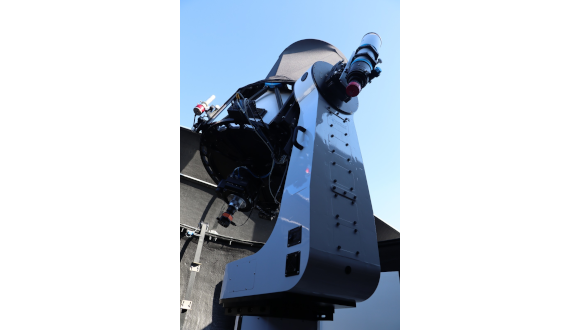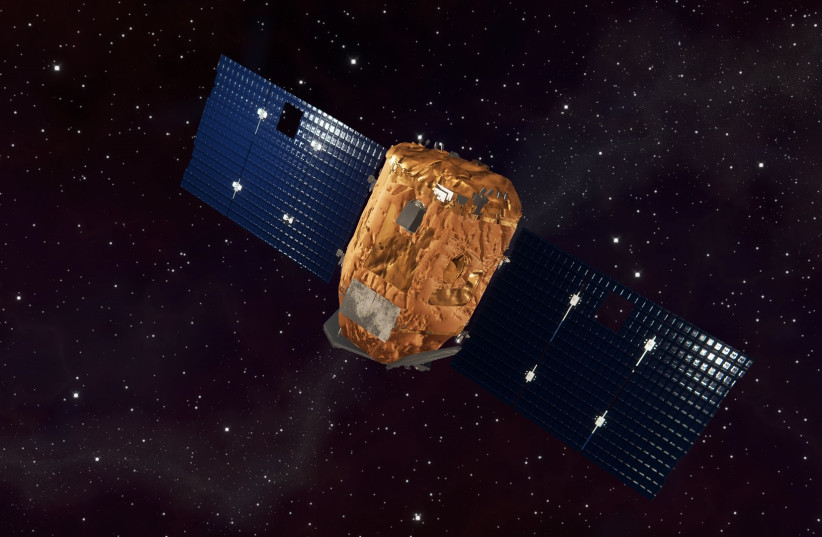TAU establishes first observatory for orbit satellite communication
The station includes a satellite observatory dome with a diameter of 4.25 meters, a tracking system, a primary high-speed camera and more.
 |
| Telescope at the TAU ground station. Photo: Tel Aviv University |
Tel Aviv University (TAU) scientists have built the first ground station in Israel – among the most advanced in the world – for tracking and sensing hyperspectral imaging and optical and quantum communication with satellites in orbit around the Earth.
The station includes a satellite observatory dome with a diameter of 4.25 meters, a tracking system, a primary high-speed camera and secondary tracking cameras, laser equipment, single-photon detectors and a tracking robot that can carry two telescopes simultaneously.
“The ground station is designed for observing satellites, which are small bodies between 400 and 500 kilometers high that move at about 30,000 kilometers an hour,”
Prof. Yaron Oz, head of TAUs Center for Quantum Science and Technology
At this stage, the robot arm holds a 61-centimeter telescope, and in the next stage, the observatory will be equipped with another telescope designed for photography in the infrared range, as well as thermal and hyperspectral cameras.
“The ground station is designed for observing satellites, which are small bodies between 400 and 500 kilometers high that move at about 30,000 kilometers an hour,” said Prof. Yaron Oz, head of TAU’s Center for Quantum Science and Technology. “The ability to track satellites is a very precise skill. The satellite passes by very quickly, and during this time, you have to photograph it in the center of the image and in several different ranges of the electromagnetic spectrum in order to learn details about it.”
 VENµS satellite (credit: ISRAEL AEROSPACE INDUSTRIES)
VENµS satellite (credit: ISRAEL AEROSPACE INDUSTRIES)In addition to regular optical communication, which uses lasers or LEDs of different wavelengths, the new ground station will also enable the conduction of experiments in quantum optical communication. Advanced communications use the quantum properties of individual photons to transmit encrypted information.
“Theoretically speaking, quantum communication is completely encrypted,” Oz said. “It is impossible to launch a cyberattack and copy the information because in quantum mechanics, there is a principle that prevents copying. As soon as a third party tries to intercept a message, they destroy the original signal, for example, by changing the polarization of the photons, and both communicating parties will know that someone tried to listen in on them. That’s how it works in theory. In practice, there are quite a few research questions that need to be answered.”
For example, he said, “what do we do with interference in a signal that is not created as a result of attempted eavesdropping, but rather, for example, from the weather? Should we use qubits [quantum bits, the counterpart in quantum computing to the binary digit or bit of classical computing] or qudits [photons that have more than two states]? And more generally, how much information can be transmitted this way within the limited transmission time in which the satellite passes over the ground station?”
Tel Aviv University establishes the first satellite observatory for quantum optical communication
The list of unanswered questions is long. Quantum communication is a completely experimental field. There are protocols from experiments conducted in labs, but the only country that has successfully demonstrated such communication is China, which did so in 2016.
The Americans also apparently succeeded in this, but they published nothing about it in scientific journals. Apart from these two superpowers, a few countries, including Germany, Singapore and now Israel, are preparing to demonstrate this capability.
What are the phases?
In the first phase of the project, the TAU researchers will try to establish optical communication followed by quantum communication between ground stations, between ground stations and drones and then between ground stations and a satellite of one of their international partners. Within two to three years, the researchers hope to raise the funds to build a dedicated “blue-and-white” quantum satellite.
“We are employing the ‘tower and stockade’ method,” Oz said. “In the beginning, we will place a transmitter on the roof of the second building of the School of Physics in an attempt to produce an immune quantum key with a rate of hundreds to thousands of bits per second, with the aim of learning and improving the positioning, switching and synchronization capabilities of the light sources and the single-photon detectors.
“Later, we would like to reduce the size of the transmission system and integrate it into an airborne system, initially with drones, and establish a network of quantum communications. Ultimately, we would also like to launch our own satellite, which will try to establish quantum communication with the ground station and with a similar satellite in Singapore.”
It may not be Mars, but it’s a start: Tel Aviv University launches nanosatellite
PLEASE RECOMMEND THIS PAGE & FOLLOW THE SPUTNIKS ORBIT AT HTTPS://DISQUS.COM/HOME/FORUM/THESPUTNIKSORBIT-BLOGSPOT-COM


No comments:
Post a Comment